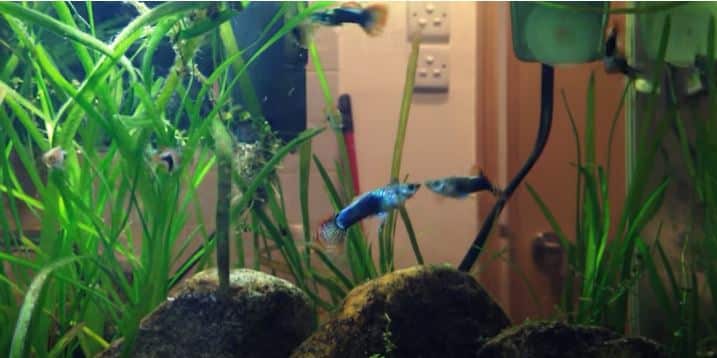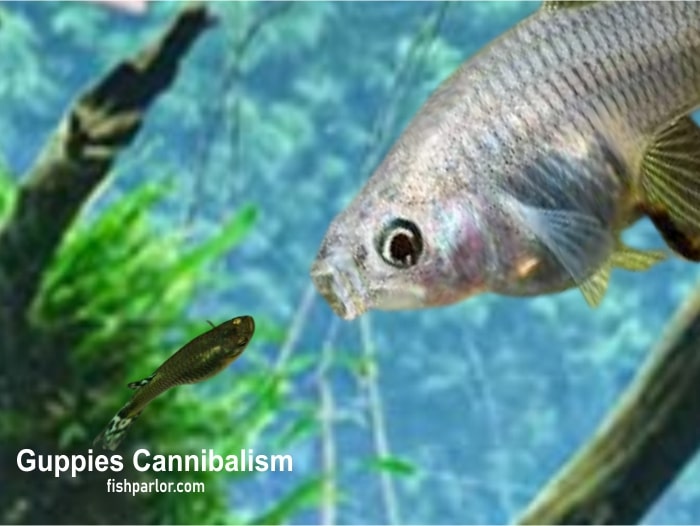Guppies are naturally peaceful and social. However, males become aggressive when establishing dominance in a territory. They can also fight over a female. Female guppies can fight off other fish when pregnant or after giving birth if they feel threatened.
Frequently monitor signs of combative behaviors and dangerous aggression. Signs to look out for include impaired fins, aggressive chasing, hiding for long, and even dead fish in some cases.
Many tend to keep male guppies because of their intense colors and fancy tails. Yet, having females in the tank is vital for ensuring the males are busy most of the time. If not eating, guppies utilize their time mating. Without females in a tank, males will spend time confronting each other.

Reasons why guppies fight
Before stopping aggressive behaviors, the causes must be established. Knowing when they are playing or fighting is also good because the two situations can sometimes be confusing. Below are the leading causes of fights among guppies.
1. Poor ratio of male guppies to female
With every passing minute, a male guppy tries mating. Thus the males will persistently battle and harass each other to obtain the female’s attention. This happens if there are more females than males in an aquarium.
Females will be stressed since males regularly fight and chase them. Stressed and frustrated female guppies may end up fighting and harassing other frail or smaller females in the tank. This action can sometimes result in guppy cannibalism, a rare habit among the species.
Every male guppy should have at least three female guppy fish to have options. This will also avoid stress among females. A peaceful environment in a tank increases their lifespan.
2. Establishing territories
Male guppies establish dominance over others to claim their sections in a habitat. That is the main reason why male guppies fight a lot. A dominant, powerful male will have the first opportunity of mating with the females.
If there is a dominant male, others will avoid particular locations in a tank. Intimidating and stronger guppies spend their time in the marked areas. A weak guppy will be attacked if it finds itself in a marked region. This is the main reason why it is not good to keep male guppies alone.
Aggressive guppies can also form a group of two or three and stay together, away from the weaker or smaller ones. The vulnerable ones will have difficulty competing with dominant males for mating, which can stress them.
3. Space
Guppies grow to about two inches long. Therefore, 1-2 guppies should be kept in at least an 18-20 liter tank. When males and females are housed together, they mate and reproduce almost every month. Therefore, the larger the tank, the better for them.
A female guppy delivers more than 20 frys in a single birth. Within a short time, a small-sized tank will be overcrowded. Therefore, keep 2 males and 6 females in a ten or 20-gallon aquarium.
Without enough space in a tank, expect constant fighting among the males as they try to eliminate the weaker ones.
4. Poor water conditions
Closely monitor tank water parameters like temperature, pH levels, and hardness. The parameters have to be excellent for healthy living. Also, essential minerals, including calcium and magnesium, must be safer.
Poor water conditions stress guppies and push them to fight each other or their tank mates. Additionally, since a pregnant guppy will likely be moody, it becomes easier for poor water conditions to trigger a brawl with other guppies.
A sign of inappropriate water parameters is the presence of debris and waste in the tank. Guppies can leave alone; if the fighting persists, they can be isolated. The favorable conditions of the aquarium for guppies are:
- 72-82 degrees F water temperature. Since the new species of guppies may not be as resilient and hardy as wild guppies, a 76 to 78°F temperature is also okay.
- 6.8-7.8 pH level.
- 8-12 water hardness.
- Toxic gasses like ammonia and nitrite should be less than 0 ppm (parts per million).
6. Little or no food
A dominant and starving guppy will try to get a more significant share of food by bullying and harassing the weaker ones. A continuation of food scarcity increases the display of aggressiveness, bullying, and violence. Such conditions can stress and even kill pregnant guppies in a tank.
How to know if guppies are fighting or playing
For beginners, it can be difficult to know if guppies are playing or fighting. While playing, guppies can chase each other and peacefully rub on contact. This is okay, especially if it is a male and a female involved.
Fighting gupies is easily noted among males since they like fighting as compared to females. Constant fear can be noted among the weaker ones because they will spend most of their time hiding. Damaged fins on a male guppy is also a clear indication that they are fighting and nibling at each other.
Guppies love interacting, socializing, and playing in a peaceful environment with sufficient food. Harmless interaction can be seen through erratic but safe, playful swimming across the tank as they chase each other. That assists guppies in strengthening their friendships and remaining active and healthy.
Guppies fighting causes stress and injuries and wounds to each other. Physical injuries include damaged fins and tails, injury marks on the body, and displaced scales. Another sign of fighting is that weaker guppies feel intimidated and must run away to hide.
Guppies frightened of dominant ones hide in caves, under or between tank decorations. During feeding, the frightened ones fear attack and wait for the few leftovers.
Should I separate fighting guppies?
You should separate fighting guppies because it can get dangerous eventually. A weaker guppy’s severe injuries and wounds can be fatal if an infection occurs. Put the dominant guppy in another tank, away from the weaker guppies.
Guppies cannot fight to the death. However, the battling of your aquatic friends can lead to their deaths. Guppies do not directly kill each other by fighting. What happens is that a seriously injured fish has a higher possibility of getting a disease or an infection that kills it.
How to stop guppies from fighting
Stop guppies from fighting by achieving and maintaining peace and friendship in the tank by following these tips.
- Provide enough food.
- The number of males in the tank should not be more than females. Keep a male guppy with approximately three or four female guppies.
- Provide a bigger tank so that there is no overcrowding.
- Add decorations such as logs, caves, and live plants to provide hideouts for weak and threatened guppies.
- If the fighting persists, separate them.
- Maintain the proper aquarium conditions. For instance, replace 15 to 25% of the tank water weekly to remove contaminants that may fuel aggressive behavior.
Are guppies fighting or mating?
Males chasing females, in most cases, mean no harm. They want to play or mate. That should not be confused with a fight. There is a typical level of hounding that is for mating. The males pursue the females, and there are no fighting signs.
A female guppy will only allow the fertilization of eggs inside her if she accepts the advances of a male. For there to be mating, the male guppy positions himself next to and slightly beneath the female. Males fertilize eggs using the gonopodium, which is an improved anal fin.
However, constant chasing, particularly between male guppies, signifies fighting. Look for signs of fighting and oppression, including damaged fins and other injuries.
In conclusion, if guppies chase each other and fight for fun, there should be no signs of injury or fear. They are supposed to look healthy, glow, and not feel threatened. However, guppies that are fighting need separation.
References in this article include JSTOR under Cost of sexual harassment in the guppy and The University of Nebraska on Mate choice by guppies.

